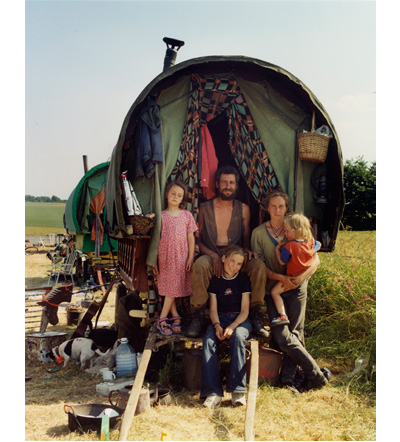
![]()
London-based fashion and social documentary photographer, Iain McKell, is notable for his arresting and unconventional images of high-fashion and youth subculture. For his recent project, The New Gypsies, McKell spent over ten years tracking and living with a small group of present-day nomads. Seeking an alternative to western capitalist society, the New Gypsies are rural anarchists. Evolving from the New Age Travellers – a group of post-punk anti-Thatcher protestors living in buses in England in the mid-80’s – the New Gypsies roam the English countryside in elaborately-decorated horse-drawn caravans, free from the reigns of urban society. Unaffiliated with the infamous ROMA gypsies residing in Central and Eastern Europe, they share no ethnographic core. Simultaneously romantic and practical, theatrical and natural, wistful and raw, McKell’s breathtaking photographs offer a first glimpse into this beautiful and subversive community. In conjunction with his current exhibit at the Clic Gallery in New York, McKell spoke with PLANET° about the origins of the project, the New Gypsies unique sense of style and visions of the future.
Click for Slideshow


![]()
Fashion and fetish have long been cultural bedfellows. Steeped in fantasy, obsession and sex both compliment and provoke each other. This kinky kinship is infusing the runways this season – restrained silhouettes nipped at the waist, fetishized footwear from lace-up boots to furry stilettos and leather everywhere – channeling in a subversive new trend. At the forefront of fashion’s strict new discipline is the London-based design duo Fleet Ilya. The husband and wife team are making worldwide waves with their handcrafted leather accessories.
Ilya Fleet trained as a saddlery craftsman before using his trade to create the label’s collection of luxury bondage accessories, Restraint. Resha Sharma joined Ilya as creative partner with a graphic design degree from Central Saint Martins and brought the label into the fashion realm with a collection of women’s accessories. Now both their bondage and fashion pieces can be found accessorizing international fashion editorials and at the world’s top boutique and concept stores.


AIDS Poster Boy

David Weissman’s last documentary, co-directed with Bill Weber, was a Technicolor portrait of the Cockettes, the highest-flying drag queen ensemble in 1960s San Francisco. For his next non-fiction project Weissman moves on to the following chapter of life in that city’s gay community, after the euphoria of finding each other has given way to the struggle of staying together. We Were Here, also co-directed by Weber and opening September 9th in New York, is a gracefully elegiac remembrance of the 1981 emergence of AIDS in San Francisco and the magnificent response of ordinary citizens during the earliest days, before the disease was understood or even named. Weissman follows five central figures, weaving together the perspectives of medical professionals, city caregivers, and, in what are inevitably the most harrowing interviews, those with stricken loved ones. An undercurrent of testimonial pervades the film; as much as it is about enormous courage, it is still the tale of those who died, and this weight has not been lost on anyone in front of or behind the camera.
David Weissman moved to San Fransisco five years before AIDS was discovered in the city. He spoke with PLANET about the enormous repercussions of the initial AIDS panic and why San Francisco is still an extraordinary city.

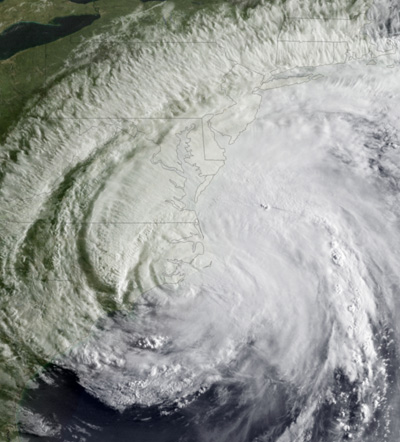
Hurricane Irene Makes Landfall - Visible Satellite Image
There is a difference between climate and weather. What happens on one day can be very different from what’s happening across the long-term.
This is an oft-repeated line in climate science, and it usually serves as the go-to talking point in any discussion begun by the question, “Does this storm have anything to do with global warming?” The average climatologist out there isn’t going to put his or her credibility on the line to tell you that any single weather event can be attributed to anthropogenic climate change, and with that being the case, this same statement is made time and again: “There is a difference between climate and weather…”
In the aftermath of Hurricane Irene, as tree limbs are removed from power lines and water is pumped from basements across portions of the Northeast, let’s put matters of climate aside for a moment and take a quick look at some of the weather that 2011 has brought in its first eight months.
Deep inhale. There were historic blizzards to begin the year in much of the U.S., including many of the same states affected by Irene; the extreme rains that flooded 18,000 homes in Brisbane, Australia; the floods and mudslides that hit Brazil and caused some 900 fatalities; the monumental tornado season that tore up much of Tuscaloosa, Alabama and Joplin, Missouri; the flooding along the lower Mississippi, after the melting of heavy snowpack, that cost as much as $4 billion in damages; the droughts in places such as Texas, which experienced its driest period in history, prompting its governor to hold a Mayan-style prayer for rain;


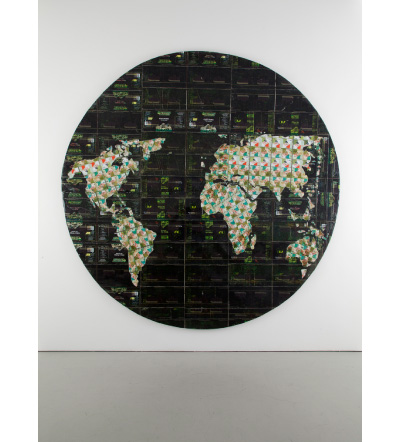
Adel Abdessemed. mappemonde - olive, 2011. Courtesy the artist and David Zwirner, New York. Photograph by Jean Vong
It’s been 19 months since the monstrous 7.0 magnitude earthquake struck Léogâne, Haiti (16 miles west of Port-au-Prince) on January 12, 2010. Despite the unprecedented outpouring of global aid, funds and support, Haiti remains consumed by the aftermath of what the quake left behind. According to official estimates, 300,000 people were injured, 1.3 million displaced, 97,294 houses destroyed and another 188,383 damaged. To say nothing of the disputed death toll, subsequent cholera outbreak, political unrest, and general foot-dragging of aid disbursement and reconstruction projects. Quite simply, the Haitian people have suffered inexorably and continue to do so.
Several months ago, New York gallerist/art dealer David Zwirner teamed up with comedian/actor Ben Stiller to form Artists for Haiti, a high-profile charity art auction that will donate one hundred percent of its sales to support education and health programs for Haitian children. The auction will take place on September 22 at Christie’s, New York and will include major works from some of the world’s most prominent artists including: Adel Abdessemed, Louise Bourgeois, Chuck Close, Urs Fischer, Jasper Johns, Jeff Koons, Paul McCarthy, Chris Ofili, Raymond Pettibon, Cindy Sherman, Ed Ruscha, and Zhang Huan, among others. A preview exhibition will be held at the David Zwirner Gallery in New York from September 6-10.




![]()
On August 28 the Martin Luther King Jr. National Memorial on the lawn in Washington DC will be dedicated. Three hundred thousand people are expected to attend the ceremony, thousands more than attended Dr. King’s legendary March on Washington on this same day in 1963. The monument is the first on the lawn to honor a man who didn’t serve as the country’s president. And it’s the result of decades of persistent lobbying and planning by the private foundation that raised funds and built the monument.
The Memorial shapes an axis connecting the Lincoln Memorial, where King gave his “I have a dream” speech at the end of that march, to the Jefferson Memorial, and overlooks the calm waters of the Tidal Basin. It leads visitors along a path between two large, cleft granite boulders towards a third into which sculptor Lei Yixin has carved a monumental standing figure of Dr. King. The likeness is remarkable, depicting the civil rights leader as a steely, majestic figure, looking far into the distance. President Obama is fond of repeating one of Dr. King’s best remembered sayings, “The arc of history is long, but it bends towards justice.” The Memorial illustrates how far American history has progressed, from slavery to emancipation to equal rights, and inspires us to keep moving forward.

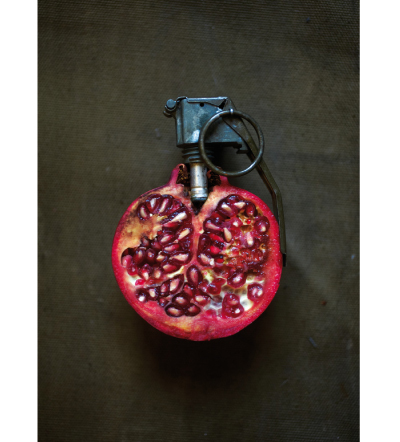
Fruit of the Boom (Granate), 2010
Good Weather, an exhibit of Berlin-based artist Sarah Illenberger’s photographs at Gelstalten Space through September 11th, is an exercise in dissonance. A simple light bulb, upon a moment’s inspection, turns out to be a pear. A minimalist pair of headphones suddenly reveals itself to be made of two cupcake wrappers strung together. Straightforward in composition, lighting, and sly good nature, an Illenberger still life is lovingly handcrafted to wreak havoc on the viewer’s expectations every time. A halved pomegranate, with only a bit of metal stuck at the top, becomes an instantly recognizable hand grenade—but hasn’t the meat’s rich color, the glisten on the seeds, the plain bloodiness of a pomegranate always spoken to your subconscious of violence? And if it didn’t, won’t it now? The joke in the photos isn’t that you’re seeing a trick object; it’s that you’re seeing two opposing images at once, and neither will yield. Illenberger spoke to PLANET about bringing her contradictions to a gallery space—right down to the name of the show.



XL Recordings
I can’t talk about who the Horrors are today without talking about who the Horrors used to be. When they made their debut in 2007 I took one look at them and thought they were a band of Peter Murphy’s disaffected nephews. They weren’t bad, but their freak-beat punk was easily over-shadowed by their vampire style. It was shocking then, in 2009, when they released Primary Colours, a psychedelic departure that drew from bands like the Velvet Underground and Spacemen 3. Skying sees the band continuing to mutate, but also establishes them as British pop preservationists.
Skying is a sunny record. It lifts the band, as the title might suggest, into the upper atmospheres of pop. The album’s first song, “Changing The Rain”, starts with a cavernous electronic beat that wouldn’t feel out of place on a Fever Ray song, but soon blossoms into synth-pop heaven.
Audio clip: Adobe Flash Player (version 9 or above) is required to play this audio clip. Download the latest version here. You also need to have JavaScript enabled in your browser.

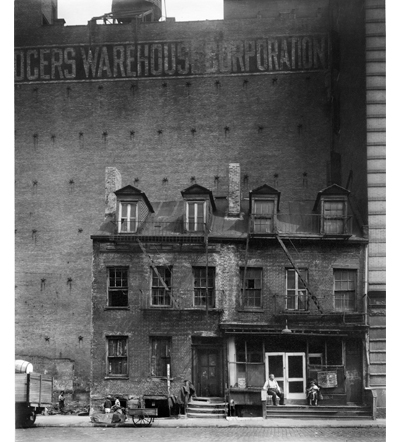
![]()
Peter Sekaer began touring the United States as a government photographer in 1936, documenting derelict cities and stricken farmland. His work, the focus of Signs of Life: Photographs by Peter Sekaer opening at the International Center of Photography on September 9th, revels less in the pointed dramatization practiced by so many of his contemporaries. Rather than produce a poised Migrant Mother, Sekaer drew his lens back and merged environment with sitter. His subjects’ everyday functionality in their new, extraordinary circumstances provided Sekaer’s narrative. The overall tableau is something very akin to what the unaffected human eye experiences.
Click for Slideshow

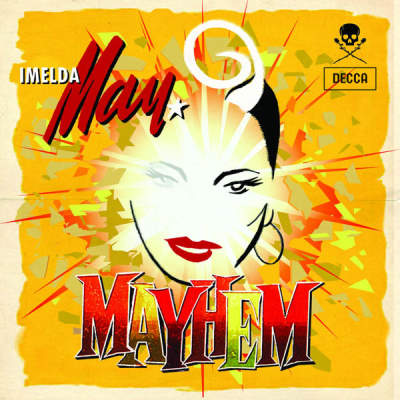
Decca Records
This Irish siren has Southern American blood running through her veins. On her third full-length, Mayhem, Imelda May’s blues and rockabilly belt-outs positively burst with confidence. Not restricted to these styles, May steps into torch-singer ballads, big-band swings, and farm-girl country vibes just as smoothly and self-assuredly. A throwback in its entirety, Mayhem’s resolute old-school style is its charm. The only touches of modernity are in the crisp production of the superior musicians and May’s ballsy tones. She purrs and growls on the slowed down rockabilly of “All For You,” alternately teasing and taunting. Her vocals stretch out moodily over the brushed drums of the bluesy “Too Sad To Cry”. At times, May traverses country territory, where she is at home amongst cowboy-bar jangles, such as the square dance-ready “Eternity”. On “Proud and Humble”, she classes up the hay-strewn barroom floors with infusions of horns. May can do it all — even strut over Soft Cell, turning “Tainted Love” into a down home sing-along.
Buy this at iTunes. After the jump, check out the video for Mayhem’s title track.






 Facebook
Facebook Permalink
Permalink Digg
Digg Reddit
Reddit LinkedIn
LinkedIn StumbleUpon
StumbleUpon Tumblr
Tumblr

